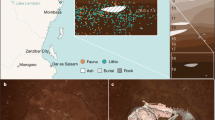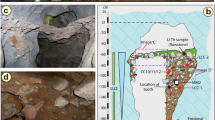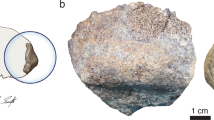Abstract
THE site of Longgupo Cave was discovered in 1984 and excavated in 1985–1988 by the Institute of Vertebrate Paleontology and Paleoanthropology (Beijing) and the Chongqing National Museum (Sichuan Province). Important finds include very archaic hominid dental fragments, Gigantopithecus teeth and primitive stone tools. Palaeomagnetic analysis and the presence of Ailuropoda microta (pygmy giant panda) suggested that the hominid-bearing levels dated to the earliest Pleistocene1. In 1992, joint Chinese–American–Canadian geochronological research corroborated the age using electron spin resonance (ESR) analysis. We report here that the hominid dentition and stone tools from Longgupo Cave are comparable in age and morphology with early representives of the genus Homo (H. habilis and H. ergaster) and the Oldowan technology in East Africa. The Longgupo dentition is demonstr-ably more primitive than that seen in Asian Homo erectus. Long-gupo's diverse and well preserved Plio-Pleistocene fauna of 116 species provide a sensitive contextual base for interpreting the early arrival of the genus Homoin Asia.
This is a preview of subscription content, access via your institution
Access options
Subscribe to this journal
Receive 51 print issues and online access
$199.00 per year
only $3.90 per issue
Buy this article
- Purchase on Springer Link
- Instant access to full article PDF
Prices may be subject to local taxes which are calculated during checkout
Similar content being viewed by others
References
Huang, W. et al. Wushan Hominid Site (Ocean, Beijing, 1991).
Wang, L. & Ouyang, L. Vertebr. PalAsiatica 20, 255–263 (1982).
Huang, W. Vertebr. PalAsiatica 31, 191–207 (1993).
Zheng, S. & Li, C. Vertebr. PalAsiatica 24, 81–109 (1986).
Zheng, S. Quaternary Rodents of Sichuan-Guizhou Area, China (Beijing, 1993).
Matthew, W. D. & Granger, W. Bull. Am. Mus. nat. Hist. 48, 563–598 (1923).
Colbert, E. D. & Hooijer, D. A. Bull. Am. Mus. nat. Hist. 102, 1–134 (1953).
Cande, S. C. & Kent, D. V. J. Geophys. Res. 97, 13917–13951 (1992).
McDougall, I., Brown, F. H., Cerling, T. E. & Hillhouse, J. W. Geophys. Res. Lett. 19, 2349–2352 (1992).
Grün, R., Schwarcz, H. P. & Zymela, S. Can. J. Earth Sci. 24, 1022–1037 (1987).
Schwarcz, H. P., Grün, R. G. & Tobias, P. V. J. hum. Evol. 26, 175–181 (1994).
Weidenreich, F. Paleontol. Sinica D1, 1–180 (text); 1–121 (atlas) (1937).
Rightmire, G. P. The Evolution of Homo erectus (Cambridge Univ. Press, 1990).
Wood, B. Koobi Fora Research Project IV: Hominid Cranial Remains (Clarendon, Oxford, 1991).
Tobias, P. V. Olduvai Gorge IV: The Skulls, Endocasts and Teeth of Homo habilis (Cambridge Univ. Press, 1991).
Brown, B. & Walker, A. in The Nariokotome Homo erectus Skeleton (eds Walker, A. & Leakey, R.) 161–192 (Harvard Univ. Press, Cambridge, MA, 1993).
Woo, J. K. Paleontol. Sinica D11, 1–94 (1962).
Zhang Yingun Am. J. phys. Anthropol. 59, 21–32 (1982).
Wang, J., Chen, S., Luo, H. & Zhong, Y. Acta Anthrop. Sin. 8, 172–176 (1989).
Ciochon, R. et al. Proc. natn. Acad. Sci. U.S.A (in the press).
Gao, J. Vertebr. PalAsiatica 13, 81–88 (1975).
Leakey, M. D. Olduvai Gorge III: Excavations in Beds I and II, 1960–1963 (Cambridge Univ. Press, 1971).
Harris, J. W. K. Afr. archaeol. Rev. 1, 3–31 (1983).
Clarke, R. J. World Archaeol. 21, 1–12 (1988).
Swisher, C. C. et al. Science 263, 1118–1121 (1994).
Wood, B. in Species, Species Concepts, and Primate Evolution (eds Kimbel, W. & Martin, L. B.) 485–522 (Plenum, New York, 1993).
Wood, B. Nature 355, 783–790 (1992).
Clarke, R. J. J. hum. Evol. 19, 699–736 (1990).
Howell, F. C. in Origin of Anatomically Modern Humans (eds Nitecki, M. H. & Nitecki, D. V.) 253–319 (Plenum, New York, 1994).
Author information
Authors and Affiliations
Rights and permissions
About this article
Cite this article
Wanpo, H., Ciochon, R., Yumin, G. et al. Early Homo and associated artefacts from Asia. Nature 378, 275–278 (1995). https://doi.org/10.1038/378275a0
Received:
Accepted:
Issue Date:
DOI: https://doi.org/10.1038/378275a0
This article is cited by
-
The first human dispersal to Europe: Remarks on the archaeological and palaeoanthropological record from Orce (Guadix-Baza basin, southeastern Spain)
Human Evolution (2002)
-
Out of Africa and back again
International Journal of Anthropology (2000)
Comments
By submitting a comment you agree to abide by our Terms and Community Guidelines. If you find something abusive or that does not comply with our terms or guidelines please flag it as inappropriate.



